Related Research Articles

The Toccata and Fugue in D minor, BWV 565, is a piece of organ music written, according to its oldest extant sources, by Johann Sebastian Bach (1685–1750). The piece opens with a toccata section, followed by a fugue that ends in a coda. Scholars differ as to when it was composed. It could have been as early as c. 1704. Alternatively, a date as late as the 1750s has been suggested. To a large extent, the piece conforms to the characteristics deemed typical of the north German organ school of the Baroque era with divergent stylistic influences, such as south German characteristics.
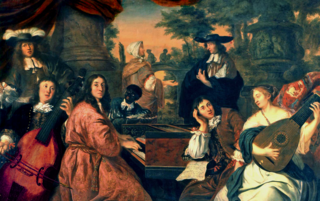
Johann Adam Reincken was a Dutch/German organist and composer. He was one of the most important composers of the 17th century, a friend of Dieterich Buxtehude and a major influence on Johann Sebastian Bach; however, very few of his works survive to this day.

Vincent Lübeck was a German composer and organist. He was born in Padingbüttel and worked as organist and composer at Stade's St. Cosmae et Damiani (1675–1702) and Hamburg's famous St. Nikolai (1702–1740), where he played one of the largest contemporary organs. He enjoyed a remarkably high reputation in his lifetime, and had numerous pupils, among which were two of his sons.
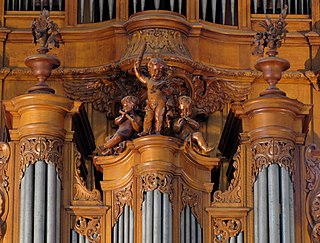
The Eight Short Preludes and Fugues, BWV 553–560, are a collection of works for keyboard and pedal formerly attributed to Johann Sebastian Bach. They are now believed to have been composed by one of Bach's pupils, possibly Johann Tobias Krebs or his son Johann Ludwig Krebs, or by the Bohemian composer Johann Caspar Ferdinand Fischer.

St. Catherine's Church is one of the five principal Lutheran churches (Hauptkirchen) of Hamburg, Germany. The base of its spire, dating from the 13th century, is the second oldest building preserved in the city, after the lighthouse on Neuwerk island. It is situated on an island near what was formerly the southern boundary of the medieval city, opposite the historic harbour area on the Elbe river. It traditionally served as the church of the seamen.
Wolfgang Friedrich Rübsam is a German-American organist, pianist, composer and pedagogue.

Johann Sebastian Bach was a German composer and musician of the late Baroque period. He is known for his orchestral music such as the Brandenburg Concertos; instrumental compositions such as the Cello Suites; keyboard works such as the Goldberg Variations and The Well-Tempered Clavier; organ works such as the Schubler Chorales and the Toccata and Fugue in D minor; and vocal music such as the St Matthew Passion and the Mass in B minor. Since the 19th-century Bach revival he has been generally regarded as one of the greatest composers in the history of Western music.
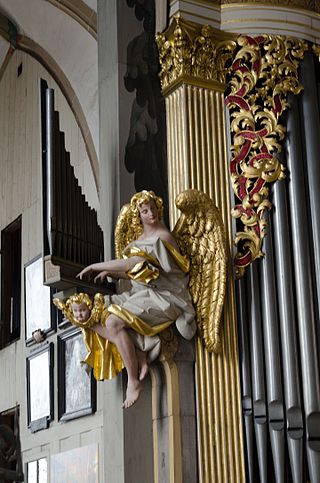
Prelude and Fugue in A minor, BWV 543 is a piece of organ music written by Johann Sebastian Bach sometime around his years as court organist to the Duke of Saxe-Weimar (1708–1713).
Johann Peter Kellner was a German organist and composer. He was the father of Johann Christoph Kellner.

The Great Eighteen Chorale Preludes, BWV 651–668, are a set of chorale preludes for organ prepared by Johann Sebastian Bach in Leipzig in his final decade (1740–1750), from earlier works composed in Weimar, where he was court organist. The works form an encyclopedic collection of large-scale chorale preludes, in a variety of styles harking back to the previous century, that Bach gradually perfected during his career. Together with the Orgelbüchlein, the Schübler Chorales, the third book of the Clavier-Übung and the Canonic Variations, they represent the summit of Bach's sacred music for solo organ.

The Bach-Busoni Editions are a series of publications by the Italian pianist-composer Ferruccio Busoni (1866–1924) containing primarily piano transcriptions of keyboard music by Johann Sebastian Bach. They also include performance suggestions, practice exercises, musical analysis, an essay on the art of transcribing Bach's organ music for piano, an analysis of the fugue from Beethoven's 'Hammerklavier' sonata, and other related material. The later editions also include free adaptations and original compositions by Busoni which are based on the music of Bach.

The Clavier-Übung III, sometimes referred to as the German Organ Mass, is a collection of compositions for organ by Johann Sebastian Bach, started in 1735–36 and published in 1739. It is considered Bach's most significant and extensive work for organ, containing some of his most musically complex and technically demanding compositions for that instrument.

"An Wasserflüssen Babylon" is a Lutheran hymn by Wolfgang Dachstein, which was first published in Strasbourg in 1525. The text of the hymn is a paraphrase of Psalm 137. Its singing tune, which is the best known part of the hymn and Dachstein's best known melody, was popularised as the chorale tune of Paul Gerhardt's 17th-century Passion hymn "Ein Lämmlein geht und trägt die Schuld". With this hymn text, Dachstein's tune is included in the Protestant hymnal Evangelisches Gesangbuch.
The Fantasia or Pièce d'Orgue in G major, BWV 572, is a composition for organ by Johann Sebastian Bach.
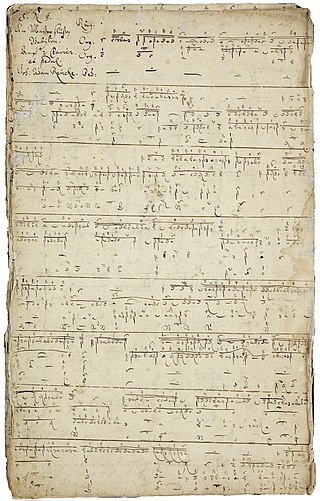
An Wasserflüssen Babylon is a chorale fantasia for organ by Johann Adam Reincken, based on "An Wasserflüssen Babylon", a 16th-century Lutheran hymn by Wolfgang Dachstein. Reincken likely composed the fantasia in 1663, partly as a tribute to Heinrich Scheidemann, his tutor and predecessor as organist at St. Catherine's Church, Hamburg. With its 327 bars, it is the most extended repertoire piece of this kind. Reincken's setting is a significant representative of the north German style of organ music.
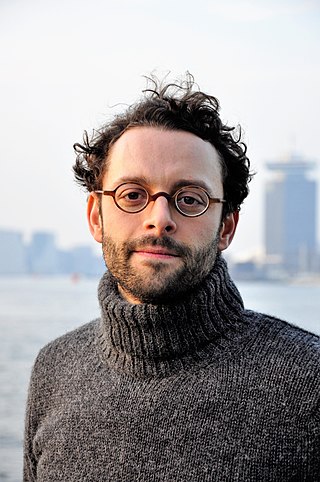
Benjamin Alard is a French classical organist, harpsichordist and clavichordist.
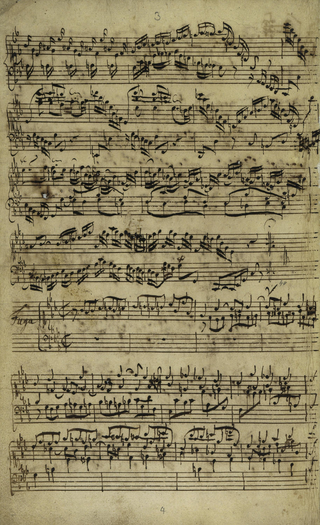
Fantasia and Fugue in C minor, BWV 906, is a keyboard piece, likely unfinished, composed by Johann Sebastian Bach sometime during his tenure in Leipzig (1723–1750). The work survives in two autograph scores, one with the fantasia alone, and the other, believed to have been penned around 1738 in which the fugue is incomplete. The piece is notable for being one of Bach's latest compositions in the prelude and fugue format, and for being a showcase of Bach trying his hand at the emerging galant and empfindsam styles of music that his sons were known to compose.
References
- ↑ Williams, Peter (2003), The Organ Music of J. S. Bach (2nd ed.), Cambridge University Press, ISBN 978-0-521-89115-8
- ↑ Yearsley, David (2012), Bach's Feet: The Organ Pedals in European Culture, Cambridge University Press, ISBN 978-0521199018
- ↑ According to Bach's obituary the two met in "about 1722".
- ↑ Researchers find Bach’s oldest manuscripts. 2006. Associated Press.
- ↑ Bates (2008)
- ↑ Bates (2008), pp, 82–83
- ↑ Bates (2008), p. 60
- ↑ Bates (2008), p. 29